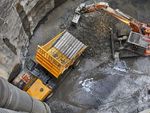City Rail Link Ventilation and Dust Extraction Solution - Karangahape Station Construction - Grydale
←
→
Page content transcription
If your browser does not render page correctly, please read the page content below
City Rail Link
Ventilation and Dust Extraction Solution
Karangahape Station Construction
City Rail Link Case Study grydale.com.auCity Rail Link Project
Full extract ventilation system design and dust control supply
Client City Rail Link (CRL)
Location Auckland, New Zealand
Ventilation system design and
Application
dust control
Construction 2020 - 2024
Contractor Link Alliance
Full extract ventilation system
with Grydale JMS-60-MES dust
Project Summary collector and 50m3/s axial fan for
the excavation of Karangahape
Station
City Rail Link links to the existing infrastucture network
Project Overview
City Rail Link (CRL) is Auckland’s first underground K-Road will have two entrances, one at Mercury
rail line and the largest transport infrastructure Lane and one in the center of Beresford Square. The
project ever undertaken in New Zealand. CRL excavation of K-Road, which is the deepest of the
will transform the downtown Britomart Transport CRL stations at 32m below the surface. The station
Centre into a two-way through-station, doubling is being excavated by two roadheaders because the
the capacity, reducing travel times and supporting Karangahape tunnel needs to be larger than the TBM
a growing population with a world-class transit to accommodate four underground station platforms
system. which will be 150m long, suitable for nine train cars
to increase capacity from the current six. The platform
The 3.45km twin tunnel underground rail link will tunnels are maximum 8.9m high and 9.8m wide with
run up to 42m below the city centre and includes an area of 80.2m2.
the construction of two new inner-city underground
stations (Karangahape and Aotea) and rebuilding
the existing Mt. Eden Station. Construction of the
stations and tunnels is through cut-and-cover and
tunnel boring machine (TBM) methodologies,
except for Karangahape Station (K-Road) which is
being excavated by roadheaders due to its layout
and dimensions.
The main construction contract for the stations
and tunnels was awarded to The Link Alliance Joint
Venture, comprised of Vinci Construction Grands
Projects S.A.S, Downer NZ Ltd, Soletanche Bachy
International NZ Limited, WSP Opus (NZ) Limited,
AECOM New Zealand Limited, Tonkin+Taylor
Limited and CRL Ltd.
Ventilation and dust control are needed to keep
workers’ exposure to fumes and dust at safe,
acceptable levels. Grydale provided ventilation
design consulting to develop an extract ventilation
system for the excavation of K-Road Station and
supplied a JMS-60-MES dust collector and a 50m3/s
axial fan to complete this work.
K-Road Station Access
City Rail Link Case Study grydale.com.auCity Rail Link Project
Ventilation and dust control for Karangahape Station construction works
Ventilation Design
Grydale designed an extract ventilation system for Construction began in August 2020 with the
K-Road in which air is drawn through the tunnel Mercury Lane temporary shaft, which is 15m wide
using negative pressure from the outside and and 27m deep. The shaft serves as an access point
exhausted via ducting to a dust collector, delivering to the mined tunnels for all excavation equipment.
clean air to the atmosphere. Ventilation requirements for the excavation of the
temporary shaft were met by a 90kW axial fan with
The K-Road ventilation design is separated into an open circuit capacity of 46m3/s. The axial fan
15 construction stages and has been designed continued be used throughout the construction
around the last stage, where the maximum air flow of K-Road to increase air flow into the tunnel to
is required. Each stage represents changes to the balance the extraction rate.
tunnel area as construction advances. The required
capacity of the ventilation system is determined The fan is mounted alongside the dust collector on
by air flow, diesel plant and number of workers to the mezzanine of the acoustic shed on the surface,
ensure there is sufficient clean air within the tunnel and connected via 1600mm steel ducting to the
to meet health and safety regulations. excavation area via the shaft. The use of rigid steel
ducting helps to reduce the pressure loss within
Ventilation modelling confirmed that a 450kW, the ventilation design.
60m3/s dust collector would meet the requirements
for the entire excavation of K-Road station. Grydale Following completion of the shaft, a combination
provided a JMS-60-MES mobile dust collector of forced and exhausted ventilation systems have
named “Jonah”. The unit features a Variable Speed been implemented to ventilate the mined tunnels
Drive (VSD) which allows air flow to be reduced and adits being excavated by Mitsu S200 and S300
during the early stages of construction and turned roadheaders.
up as construction advances.
CRL Stations and Tunnels
City Rail Link Case Study grydale.com.auCity Rail Link Project
Overcoming challenges for the construction of Karangahape Station
Karangahape Station Construction Current Status
A Mitsui S200 roadheader was launched from the As of July 2021, the second roadheader is excavating
Mercury Lane shaft to excavate the first tunnel the tunnel from Beresford Shaft to Mercury Lane
platform and two adits along the way before breaking at K-Road Station. The CRL project is scheduled to
through at the Beresford shaft. The tunnel stub (where complete in 2024.
the passing TBM will pick up excavation within the
station) was excavated using a twin header on a 14T
“Grydale is proud to be working on this key infrastructure
excavator.
project in Auckland and will continue working closely with
the project team to ensure ventilation and dust control
The second roadheader, a Mitsui 300, was then used to
requirements are met for the remainder of construction
overcut the tunnel and brattice was installed to block
works”.
open sections of tunnel that would otherwise have
Thomas Ioramo, General Manager, Grydale
resulted in air loss to create sections within the tunnel.
Once brattice work was complete, the Mitsui 200 was
launched in the second tunnel and the same extraction
method is now being used as the roadheader
progresses back toward Mercury Lane.
Unique Challenges
Positioning Constraints
The urban location and construction method at
Mercury Lane pose numerous space and noise
constraints. To keep noise down and equipment
out of sight, an acoustic shed houses all ventilation
equipment at surface-level. The height of the
mezzanine required the JMS-60-MES to be modified,
so Grydale custom-designed the equipment to allow
the exhaust silencer to be rotated 90 degrees (from the Grydale JMS-60-MES Mobile Electric Skid Dust Collector
roof) to allow sufficient clearance.
Remote Service Support
Grydale has an in-house service and maintenance
team, however restrictions on travel as a result of the
COVID-19 pandemic meant our team needed to find a
way to provide product service and support remotely,
including the onsite commissioning of the dust
collector and axial fan. This was effectively undertaken
using live video support.
Local Spare Parts
Ventilation and dust extraction are key to providing a
safe work environment, so keeping the dust collector
operational throughout the excavation process is
critical. To ensure there was a local supply of spare
parts, Grydale delivered a 20ft shipping container with Grydale 90 kW, 50m3/s Axial Fan
critical parts and service kits, including an extra set of
filters, to the job site.
City Rail Link Case Study grydale.com.auGrydale DC Pty Ltd
Part of the Grydale Group Pty Ltd
Building 2, 15 Pinacle Street,
Brendale, QLD 4500
+61 1300 929 349
enquiries@grydale.com.au
www.grydale.com.au
ABN: 23 140 112 394
City Rail Link Case Study grydale.com.auYou can also read



























































